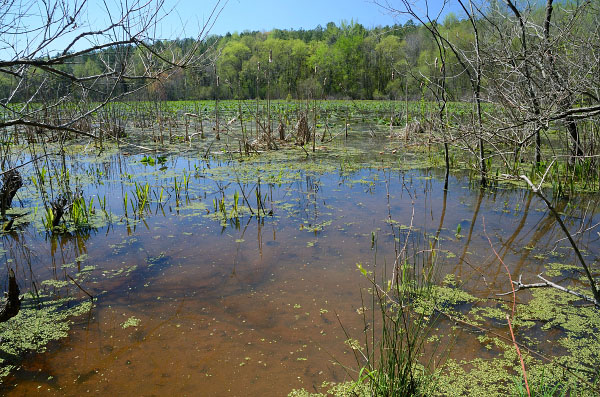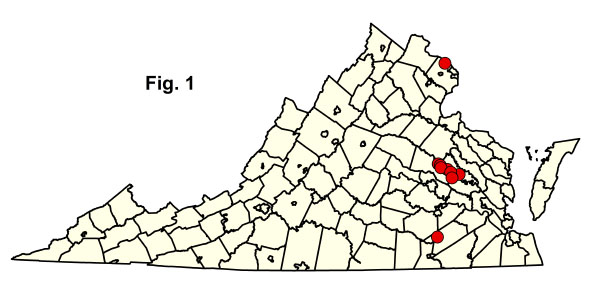
 Sở Bảo Tồn và Giải Trí
Sở Bảo Tồn và Giải Trí Bảo Tồn. Bảo Vệ. Tận Hưởng.
 Sở Bảo Tồn và Giải Trí
Sở Bảo Tồn và Giải Trí  Mục lục
Mục lụcAo và hồ nước ngập lụt
Semipermanently to permanently flooded ponds or pools are uncommon natural features of major Coastal Plain and Piedmont floodplains. These wetlands are typically developed in abandoned oxbows and cut-off meanders, ranging in size from less than 0.01 ha to about four ha (0.2 to 10 ac). Community composition is probably influenced by a combination of environmental factors, including flooding regime, water depths, soil fertility, and degree of shading. Dominant vegetation varies from woodlands and shrublands in shallower, semipermanently flooded ponds to submerged or floating aquatics in deeper ponds. Scattered bald cypress (Taxodium distichum), tupelos (Nyssa aquatica and Nyssa biflora), green ash (Fraxinus pennsylvanica), or red maple (Acer rubrum) are sometimes rooted in large Coastal Plain oxbow ponds. More often, shrublands dominated by buttonbush (Cephalanthus occidentalis) or swamp loosestrife (Decodon verticillatus), or non-tidal marshes dominated by arrow-arum (Peltandra virginica), smartweeds (Persicaria spp.), and swamp rose-mallow (Hibiscus moscheutos), are established. In the more deeply flooded ponds, aquatic species prevail, with or without scattered shrubs and emergents such as Virginia chain fern (Woodwardia virginica), sedges (Carex spp.), and eastern mannagrass (Glyceria septentrionalis). Typical aquatics include common mermaid-weed (Proserpinaca palustris), bladderworts (Utricularia spp.), common spatterdock (Nuphar advena), duckweeds (Lemna spp.), duckmeal (Spirodela spp.), large water-starwort (Callitriche heterophylla var. heterophylla), water shield (Brasenia schreberi), hornworts (Ceratophyllum spp.), waterweeds (Elodea spp.), American frog's-bit (Limnobium spongia), pondweeds (Potamogeton spp.), eastern mosquito fern (Azolla caroliniana), milfoils (Myriophyllum spp.), and shade mudflower (Micranthemum umbrosum).
Có ít nhất hai loài thực vật thủy sinh được tìm thấy trong các cộng đồng này, đó là cây chân quạ nước vàng (Raunculus flabellaris) và cây lá kim (Hottonia inflata), là loài cực kỳ quý hiếm hoặc không phổ biến. Mặc dù dường như thường liên quan nhiều hơn đến ao hải ly (xem nhóm cộng đồng sinh thái hồ chứa bán vĩnh cửu ), các đầm lầy nổi không chịu tác động của thủy triều hiện diện ở các khúc sông lớn của Sông Pamunkey ở phía đông Virginia. Các vùng đất ngập nước trong nhóm này là môi trường sinh sản quan trọng của rùa và động vật lưỡng cư, bao gồm cả loài kỳ nhông đất quý hiếm (Ambystoma talpoideum). Các ao hồ ở vùng đồng bằng ngập lụt phát triển tốt dường như là những cộng đồng khá hiếm và cần được kiểm kê và nghiên cứu thêm nhiều.Tài liệu tham khảo: Fleming (2007), Walton et al. (2001).
Nhấp vào đây để xem thêm ảnh về nhóm cộng đồng sinh thái này.
 © DCR-DNH, Gary P. Fleming.
© DCR-DNH, Gary P. Fleming.

 Tải xuống bảng tính thống kê tóm tắt thành phần cho từng loại cộng đồng được liệt kê bên dưới.
Tải xuống bảng tính thống kê tóm tắt thành phần cho từng loại cộng đồng được liệt kê bên dưới.

